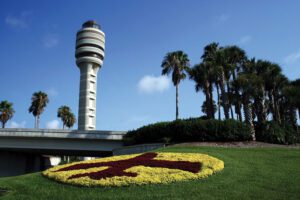Maintaining a financially responsible approach to preparing for future growth, the Greater Orlando Aviation Authority (GOAA) Board considered several funding issues recently. The Board got its first look at the preliminary 2023-2024 Fiscal Year Budget for Orlando International Airport (MCO) and Orlando Executive Airport (ORL).
 The budgets reflect the Authority’s desire to keep up with increasing passenger growth as well as passenger expectations, while providing an exceptional travel experience for all customers.
The budgets reflect the Authority’s desire to keep up with increasing passenger growth as well as passenger expectations, while providing an exceptional travel experience for all customers.
With traffic totals expected to surpass 54 million annual passengers and year over year totals through May 2023 having grown by 13.3 percent, the Board approved an $831.6 million preliminary budget for MCO and a $5.7 million preliminary budget for ORL.
The MCO budget represents a $148 million increase over Fiscal Year 2023. Despite the effects of inflation on other segments of the marketplace, GOAA has been able to mitigate negative influences in certain aspects of air travel, while generating revenue increases in others. Key elements of the proposed budget include:
- An average Cost Per Enplaned passenger (CPE) that is 8.7% lower than the previous year, which remains competitive compared to other large hub airports.
- A $49.2M increase in Ground Transportation revenue as a result of forecasted growth
- An increase of $15.3M in airline rental fees & charges
- A $9.8M increase in Hotel revenue
- An $8.1M increase in Concessions revenue
The FY2024 budget for Orlando Executive Airport is $5,708,100, which is $943,100 more than last year. ORL’s proposed budget reflects increases in aircraft-related and commercial property revenues.
Following today’s Board approval, the Orlando City Council will conduct a public hearing on the preliminary budget before it returns to the Aviation Authority for final approval.
CAPITAL IMPROVEMENT PLAN UPDATE
Building to meet demand continues to drive the Aviation Authority’s future development plans. At today’s Board meeting, an update to the Fiscal Year 2021-2028 Capital Improvement Program (CIP) was approved. Investments in airfield enhancements, terminal facilities and passenger convenience systems will add an estimated $384.4 million to MCO’s CIP and $35.8 million to ORL’s.
The CIP is a multi-year plan of major capital projects linked to the Aviation Authority’s strategic goals. The projects are developed to address airport capacity, asset preservation and replacement, customer experience and revenue enhancement.
As the Authority strives to balance the need to upgrade or replace aging facilities with providing new capacity to meet growing passenger demand, the updated CIP for Orlando International Airport will focus on the following projects:
- Airsides 1 & 3 Building Renovations
- Airsides 2 & 4 APM System Replacement
- Terminals A & B Baggage Systems Upgrades
- Power System Upgrade Projects
- Near-Term Roadway & Signage Improvements
- Preliminary Design for Terminal C Phase 2
TERMINAL C ENHANCEMENTS
In response to passenger mobility needs, progress continues on plans to add moving walkways to Terminal C. The Board voted to award a contract to TK Elevator Corporation for the installation of the conveyances between the TSA security checkpoint and the Palm Court.
The final design of Terminal C, Phase 1, did not include moving walkways. However, after listening to the concerns of the community, the Aviation Authority looked for ways to retrofit the current facility and add the conveniences where needed. The walkways are expected to improve pedestrian mobility and the customer experience.
The Greater Orlando Aviation Authority operates Orlando International Airport (MCO) and Orlando Executive Airport (ORL), two of Florida’s premier air travel gateways. MCO is a world-class global connector, serving more than 50 million annual passengers in 2022. The recently-opened Terminal C is a next level facility that will add 10-12 million annual passengers of capacity and elevate the customer experience. ORL is conveniently located just miles from downtown Orlando and provides vital general aviation access to the heart of the region.


